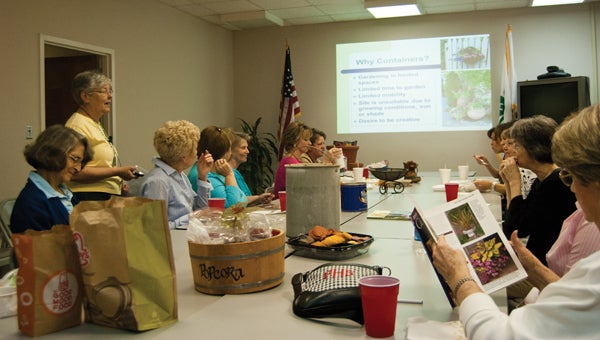Container gardening the focus of latest Lunch and Learn class
Published 3:27 pm Tuesday, April 2, 2013

Master Gardener Trisha Williams, left, talks to an Extension Lunch and Learn class Tuesday afternoon about the benefits and proper techniques of container gardening.
Master Gardener Trisha Williams made certain her presentation on creating container gardens at home provided adaptable planting tips for everyone in a Lunch and Learn class Tuesday.
As she spoke to a group of about 15 at the Chilton County Extension Office, Williams described a “container garden” as a collection of plants in pots as opposed to open gardens found in a yard.
Whether someone is a beginner gardener or a seasoned greenthumb, she said container gardening is a practical method of growing flowers, vegetables and herbs at any type of dwelling.
Container gardening is also ideal for those who are not able to walk around or kneel in an outdoor garden anymore.
“This is for people who have limited area, limited mobility and limited time,” Williams said. “Maybe you don’t have the mobility you used to have. You can still garden in containers.”
Williams emphasized the importance of using containers that will hold potting soil and provide drainage.
Traditional (porous) containers such as terra cotta pots are suitable for gardening since they hold potting soil well and contain holes at their bases.
Non-traditional (non-porous) containers such as plastic, foam or glazed pots can be used too if they hold soil mix and drain properly.
“Non-traditional containers can be anything you want to use—use your imagination,” Williams said, “As long as you provide the drainage.”
Barrels, baskets, cans, buckets and even old hiking boots can be used as containers after cleaning with a 10-percent bleach solution and drilling drainage holes where needed.
The size of the container should allow for a balance between top growth and root systems of plants.
“You need to think about how big the plants are going to be,” Williams said. “Some plants need more room for roots than others.”
Regarding container design, Williams offered three features gardens should have in order to be both functional and aesthetically pleasing: 1) “thriller” – it attracts attention with height or color; 2) “filler” – its middle is filled in with fine leaves or flowers; and 3) “spiller” – it droops over the side of the container.
“This is your garden, and you need to have fun with it,” she said.
Williams, a 2003 graduate of the Master Gardener program, teaches the houseplant section of her MG class.
Other parts of her presentation were how to choose flowers and plants based on the time of year, what types of fertilizers to use and how often to water container gardens depending on the time of year.
For instance, annuals such as petunias can be planted in the springtime; time-release fertilizers are good for container gardens with soilless mixes that do not already have fertilizers; and some gardens require watering twice a day on hot days during the summer.
For more information on container gardening or the Extension Office’s Lunch and Learn classes, call (205) 280-6268.






